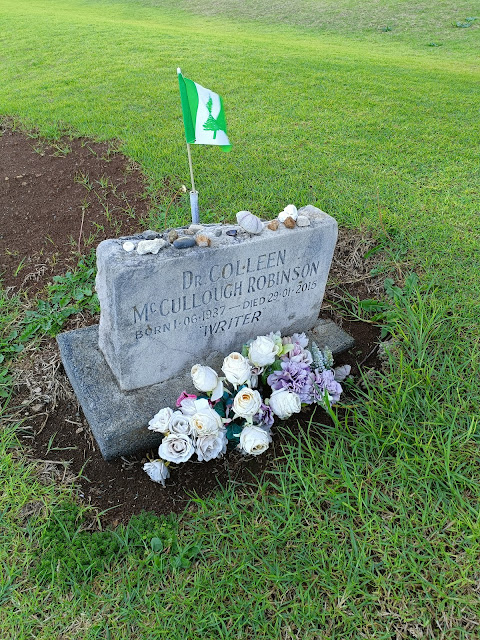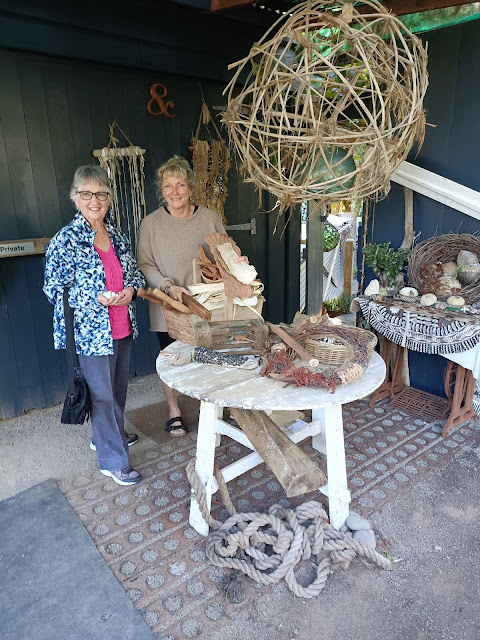http://norfolkislandandfirstfleetersandfamilies.blogspot.com.au
Return visit to Norfolk Island in 2025
Rod and Joy visited Norfolk Island 11 - 19 June 2025. I do not want to repeat myself, so if you are interested in individual families, please take a look at the posts written in 2018.
I particularly chose "Islander Lodge" on Middlegate Road for our accommodation as it overlooks Kingston - a UNESCO World Heritage Site (awarded in 2010). Just 1of 20 in Australia.
A comfortable unit with views out to Kingston historical area and Phillip and Nepean Islands.
Views from "Islander Lodge"
It is important to understand the history of Norfolk Island with their 1st, 2nd and 3rd Settlements.
Captain Cook discovered and named the island after the Duchess of Nofolk in 1774.
1st Settlement - Lieutenant Philip Gidley King arrived on 6 March 1788 with 7 staff and 15 convicts. Norfolk Island was abandoned by 1813 and all buildings were destroyed.
2nd Settlement 1825 - 1856 was designed to be extreme in convict degradation. A Penal colony.
3rd Settlement starts with "Mutiny on the Bounty". The Pitcairn community arrived on Norfolk Island 8 June 1856.
The first day of discovery included an Orientation Tour with a group on a bus. Our guide introduced us to the beauty and diversity of the island. Many of the places we visited, we returned to later in the week.
Queen Eizabeth 11 lookout was a good start as we could view Quality Row. The Georgian style street scape was built 1832-1847 to house civil and military officers and clergy. No.9 was the Royal Engineer's Quarters, now the Rearch Centre. No.10 was the Foreman of Works Quarters, now a House Museum. No11 was the Former Cleryman's Quarters. Old Military Barracks were built 1829-1834. New Military Barracks were built in 1834. Government House, one of the most intact remaining Government House buildings in Australia. Built in 1829.
Quality Row from Queen Elizabeth 11 Lookout.
Quality Row from our Unit at Islander Lodge".
Government House built 1829 Queen Elizabeth 11 lookout on the right.
Pentagonal Gaol built 1847.
Cells in Pentagonal Gaol.
"Sirius" Museum.
James Morrisby arrived on "Sirius" 19 March 1790. A sixth generation First Fleeter.
Rod was most interested in the anchor and cannon rescued from Slaughter Bay
after "Sirius" was wrecked on 19 March 1790.
Joy & Rod at Kingston. Phillip Island in the background.
The reef where "Sirius" was wrecked on 19 March 1790.
To commemorate the arrival of Lieutenant Philip Gidney King,
7 staff and 15 convicts who arrived on Norfolk Island on 6 March 1788.
Saw Pit along side the "Sirius" Museum that was the former Protestant Prisoner's Chapel.
"Islander Lodge" high on the hill.
Mt Pitt Lookout treats one to 360 degree views.
Australia is 1412 kms to its west.
There are 3 direct flights a week from Brisbane. The airport runs across the horison.
Morton Bay figs, believed to be more than 200 years old are standing along New Farm Road,
opposite Hundred Acre Reserve.
Richard Morgan's land Lot 80, 10 acres is behind the huge Morton Bay figs.
We walked about 2 km through Hundred Acre Reserve to Rocky Point.
Not far away on New Farm Road was Colleen McCullough's home.
Colleen authored 25 books, including "Morgan's Run".
Richard Morgan was an ancestor of hers and arrived on the 1st Fleet in 1790.
Rod and Joy did a tour of Colleen's house. A luxurious hideaway.
Tour show-cased her writing space, library, art and collections.
Colleen is buried in Norfolk Island Cemetery 1 June 1937 - 29 January 2015.
Anson Bay on Anson Bay Road (North west corner)
Duncombe Bay where Captain Cook land during his 2nd round voyage on 10 October 1774.
A small stone Obelisk marks roughly where Captain Cook landed in 1774.
Bird Rock Island, Cathedral Rock, Green Stone and Moo-oo Stone.
Bridle Track near where Captain Cook landed on the north side of the island.
Simon's Water was the land given to Daniel & Alice Stanfield, a Marine in the 1st fleet.
The view from Daniel Stanfield's land Lots 1&2, 60 acres each.
Rod at Ball Bay south east corner of Norfolk Island.
Joy & Jane, the present owner of Jacob Bellett's land.
Lot 25, 12 acres and Ann Harper Lot 37, 39 acres.
The ruins of Jacob & Ann Bellett's house after they were relocated to Tasmania in 1808.
Jane's father found the ruins under a lot of grown in 1979
and thought he had found a well, but it was the chimney.
The property has been well looked after.
Bloody Bridge, built 1830, on Driver Christian Road & near Bellett's land.
The story is that convicts building the bridge drew lots to murder their unpopular overseer.
They buried his body in the foundations.
His blood stained the stone work and revealed their crime.
Rod and Joy walked onto the land James Morrisby was allotted in 1790.
Lot 57, 20 acres and Lot 61, 24 acres.
Several huge Morton Bay Figs and Banyan Trees (native of India)
are growing on James Morrisby's land.
We enjoyed a great night of entertainment, delectable food and loads of humour.
We journeyed back in time as the Commondants shared their stories of
Norfolk's notorious convict settlements.
From the 1st Settlement - Lieutentant Philip Gidney King November 1791 - September 1796.
From the 2nd Settlement - James Thomas Morisset May 1829 - April 1834.
Known to be harsh & violent.
Alexander Maconochie March 1840 - February 1844
believed punishment should not be vindictive but aim to reform.
Joy and Alexander Maconochie enjoyed a laugh.
All Saints Church was originally used as a Military Store during Norfolk Island's penal days.
This 180 year old building now serves as an Anglican Church.
The lower level to the commissariat once held food supplies for the convicts and jailers.
The cemetery has been used continuously from the Colonial and Penal Settlement days
to the Pitcairn settlement in 1856 - more than 235 years.
The headstones bear testament to Adams, Christian, Nobbs and Quintal families from Pitcairn.
St Barnabas Chapel, also known as the Melanesian Mission Chapel. Dedicated 1880.
A beautiful gothic chapel, rich inside with marble and stained glass, carved stalls, encaustic tiles and brass screen work and mother of pearl. The Melanesian Mission was established 1866-1927 to train young people from Melanesian Islands as Missionaries. The roof is like an upturned boat.
This blog is just a brief look at our week long holiday in June 2025. Take a look at the other Posts for more details on individual 1st Fleeters of interest.
If you wish to make any comments, please email the author - Joy Olney on joyolney@gmail.com


















































